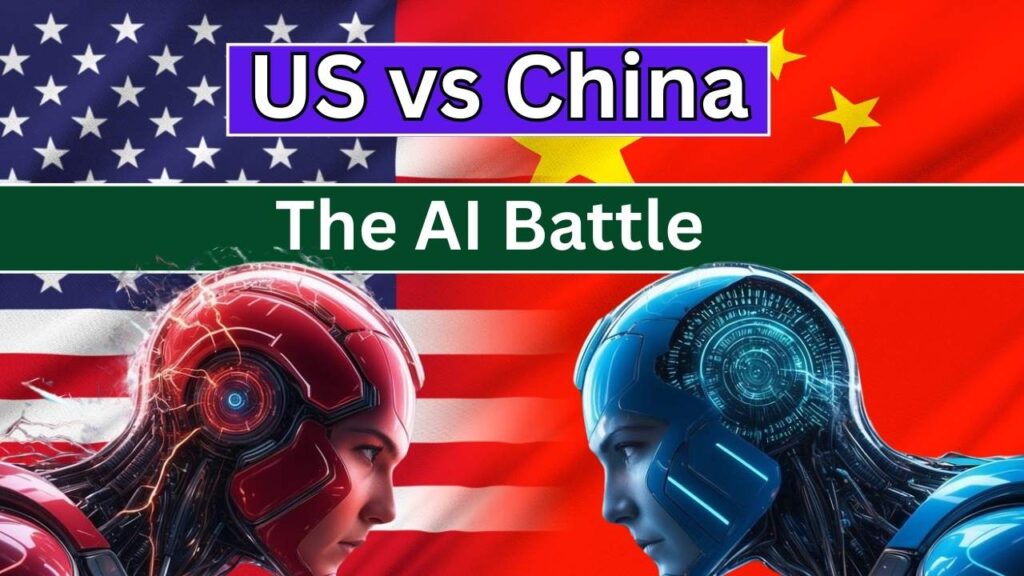The AI Battle: The rivalry between the United States and China has reached new heights in the realm of Artificial Intelligence (AI). Both countries are locked in an ongoing competition to dominate AI development, which is poised to reshape the global technological landscape. This battle is more than just about innovation—it’s a matter of strategic power, economic growth, and geopolitical influence. As the world watches this technological race, it’s crucial to understand the dynamics at play and what’s at stake for the future of AI.

In this article, we’ll dive into the AI competition between the U.S. and China, explore the key players and policies involved, and provide practical insights into how this battle will affect industries, jobs, and everyday life. Whether you’re a tech professional, an entrepreneur, or simply someone interested in the future of AI, this article will offer valuable context, detailed analysis, and expert advice to help you stay informed.
The AI Battle
| Topic | Key Information |
|---|---|
| U.S. AI Investment | $67.2 billion invested in AI by U.S. in 2023. |
| China’s AI Ambition | China aims to lead AI by 2030. |
| AI Export Restrictions | U.S. limits China’s access to advanced AI chips. |
| DeepSeek AI Model | Chinese AI startup DeepSeek uses less advanced chips to compete. |
| AI Self-Sufficiency in China | China aims for 70% semiconductor self-sufficiency by 2028. |
The U.S.-China AI competition is reshaping the global tech order, with both countries vying for dominance in a field that promises to drive economic growth and innovation. While their strategies differ, both nations recognize the transformative potential of AI and are investing heavily to capture its benefits. As AI continues to evolve, it will have profound implications for industries, jobs, and society as a whole. The challenge will be to harness AI’s power responsibly, balancing competition with cooperation to ensure that it benefits everyone.
The U.S. and China: A Technological Rivalry
The United States has long been a global leader in technology, particularly in AI. The U.S. is home to some of the world’s most influential AI companies, including Google, Microsoft, and OpenAI, and has invested heavily in AI research and development. In fact, U.S. private-sector investment in AI reached a staggering $67.2 billion in 2023, which is far ahead of any other nation, including China. This investment supports the development of AI models, from natural language processing systems like OpenAI’s GPT models to cutting-edge autonomous technologies.
On the other hand, China has rapidly emerged as a formidable challenger to the U.S. in the AI space. The Chinese government has set an ambitious target to become the global leader in AI by 2030. To achieve this, China is pouring significant resources into AI research, technology infrastructure, and talent development. The government’s strategic approach involves coordinating efforts between state-owned enterprises, private firms, and academic institutions, ensuring that AI development aligns with national priorities.
China’s focus on AI goes beyond economic competitiveness—it’s also a tool for enhancing its geopolitical influence. Through initiatives like the Digital Silk Road, China is positioning itself to set global AI standards, especially in emerging markets. Meanwhile, the U.S. is working to maintain its lead by building alliances with like-minded democracies, fostering an open and ethical approach to AI development.
How U.S. and China’s AI Strategies Differ
One of the most striking differences between the U.S. and China’s approach to AI is the role of government. The U.S. model is largely driven by private sector innovation. Companies like Google and Microsoft lead the way in research and development, while the government provides support through policies and funding. This decentralized approach encourages competition, diversity of thought, and collaboration between private companies and academic institutions.
In contrast, China’s AI strategy is heavily state-driven. The government plays a central role in coordinating research and development, directing funding, and shaping policy. This centralized approach allows China to scale up its AI capabilities quickly and effectively. However, it also raises concerns about privacy, surveillance, and ethical considerations, as China is known for using AI in monitoring its citizens.
Despite these differences, both countries share a common interest in advancing AI technologies that can revolutionize industries such as healthcare, finance, and manufacturing. AI is also seen as a key to economic growth, with the potential to create millions of new jobs and drive productivity gains across multiple sectors.
AI and Global Economic Implications
The U.S.-China AI rivalry has significant economic implications, not only for the two countries involved but for the global economy as a whole. According to a report by McKinsey, AI could add $13 trillion to the global economy by 2030, driven by advancements in productivity, automation, and innovation. As the U.S. and China race to capture this economic potential, they are also reshaping industries and job markets.
For example, AI is transforming the manufacturing industry, enabling companies to optimize supply chains, improve quality control, and automate repetitive tasks. In healthcare, AI-powered diagnostic tools and personalized medicine are improving patient outcomes and reducing costs. Financial institutions are using AI to detect fraud, assess risk, and offer personalized services to customers. The potential applications of AI are vast, and both the U.S. and China are eager to capitalize on them.
However, this competition is not without its challenges. The U.S. has imposed export restrictions on China, limiting its access to advanced AI chips and other critical technologies. These restrictions are intended to slow China’s progress and maintain the U.S.’s technological edge. In response, China is investing heavily in developing its own semiconductor manufacturing capabilities, with the goal of achieving 70% self-sufficiency by 2028.
Ethical and Security Concerns
As the U.S. and China push forward with AI development, ethical concerns have emerged, particularly around privacy, surveillance, and the use of AI for military purposes. In China, AI is increasingly being used for facial recognition and other forms of surveillance, raising concerns about individual freedoms and human rights. In contrast, the U.S. has established ethical guidelines for AI, focusing on transparency, fairness, and accountability.
AI also has significant security implications. Both the U.S. and China are investing in AI for military applications, including autonomous weapons, surveillance systems, and cybersecurity. The race to develop AI-driven defense technologies has led to concerns about an AI arms race, where advances in one country could trigger a response from the other, leading to a cycle of escalation.
The Future of AI: Collaboration or Competition?
While the U.S.-China AI rivalry is intense, there are also opportunities for collaboration. Joint efforts in AI research have historically led to groundbreaking innovations, and both countries benefit from shared knowledge and expertise. For instance, research conducted by U.S. and Chinese scientists has advanced our understanding of machine learning, neural networks, and computer vision.
Going forward, it’s essential for both countries to find ways to balance competition with cooperation. Global standards for AI governance could help ensure that AI technologies are developed and deployed responsibly. Organizations like the United Nations and the World Economic Forum are already discussing frameworks for AI ethics and regulation, and there is hope that international cooperation will help mitigate the risks associated with AI.
Sundar Pichai Reveals Shocking Truth: 30% of Google’s Code Written by AI!
Tesla, China, Samsung: The AI Arms Race No One’s Talking About!
Your Car’s New Co-Driver? Gemini AI Features Spotted in Android Auto
FAQs About The AI Battle
Q1: Why is AI important to the global economy?
AI has the potential to revolutionize industries, improve productivity, and create new jobs. It could add trillions of dollars to the global economy by automating processes, enhancing decision-making, and driving innovation.
Q2: What are the main differences between the U.S. and China’s AI strategies?
The U.S. focuses on private-sector innovation with government support, while China’s AI strategy is centrally planned by the government, with heavy investment in research, infrastructure, and talent development.
Q3: How does AI affect jobs?
AI is expected to create new job opportunities in fields like data science, AI ethics, and robotics. However, it may also displace some jobs, particularly in industries like manufacturing and transportation.
Q4: Can the U.S. and China collaborate on AI?
Yes, there are opportunities for collaboration, particularly in research. However, the rivalry between the two countries is likely to continue shaping the global AI landscape for the foreseeable future.








